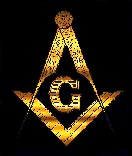Freemasonry
(see also: Knights Templar)
Article by David Claiborne
(C) Copyright 2000 All rights reserved
Freemasonry, or the rite of Free and Accepted Masons is a fraternal semi-secret society. The foundations of Freemasonry remain a mystery to many, and over the years much speculation has been given to this matter. Masonic legend tells of a secret body of stonemasons who worked on the Temple of Solomon, and managed to preserve their society into medieval Europe. More skeptical research came to the conclusion that Freemasonry evolved from medieval stonemason guilds.
While there are still some unclear matters, the evidence at hand makes a firm case for the theory that for the first four centuries of its existence, Freemasonry was a secret society formed by fugitive Knights Templar in England after mass arrests took place in France under collusion of Philip IV and the Pope. The society formed the necessary network of contacts for the men on the run. Most importantly, the knowledge brought back from the East by the Knights of the Temple was preserved. The symbolism of Masonry seems to have come from the Knights Templar's association with the Temple of Solomon.
By the time Freemasonry went public in 1717, Lodges existed across the
British Isles. Grand Lodge of England went public in 1717, and in
1725 the Grand Lodge of All England was formed. Grand Lodges in Ireland
and Scotland quickly followed. Going public does not appear to have
been an agreed upon, organized effort. Rather, it would appear that
eventually some Freemasons did not feel themselves to be in danger if exposed
to the public, and others soon followed suit..

Once known, Freemasonry spread throughout the world, attracting kings,
emperors and statesman into the fold. In the 18th century, Freemasonry
was extremely instrumental in increasing religious tolerance and scientific
study due to the many influential men living by its principles. Over
the years, Freemasonry has attracted (or made) great revolutionaries such
as George Washington, Sam Houston, Juarez, Garibaldi and Bolivar.
The Masonic imagery on the back on the American dollar bill attests to
the role Freemasonry played in the revolution of 1776. The rise of
scientific thought and religious tolerance owe a great debt to the Freemasons.
Unfortunately, despite the society's ablility to maintain and work for principles like brotherhood, charity and freedom, much of the original Templar society became lost. Freemasons had forgotten where they came from after four centuries of silence, and they began to improvise.
As more members joined their ranks, Freemasons found parallels between the tools of Masonry and various principles of the art of living. At one time, Masonic lectures would consist of examining and discussing the architecture of medieval cathedrals, as if some esoteric wisdom could be extrapolated from this. There is some indication that the early Freemasons were well educated in the art of esoteric geometry, but it is questionable whether the esoteric aspect has survived.
When the original Grand Lodge was formed, Freemasonry consisted of three degrees, what are now called the Blue Lodge degrees. Over the years, scores of new Masonic rites have popped up, such as the York Rite, and the Scottish Rite. The author is unsure whether these additional degrees developed from the syncretist attitude of the Templar tradition and contain esoteric secrets, or whether they were merely invented for sake of ceremony. There has additionally been the development of "irregular Masonry" and various Orders which have developed and split off from the Freemasonic tradition.
Inevitably, Freemasonry ran into much opposition. The religious ambiguity of Freemasonry, combined with their secret rituals, made the Church of Rome rather nervous. In addition to being denounced thoroughly by many popes, Freemasonry has been feared, fought and criticized nearly worlwide at one time or another during its existence. In the early 19th century, an Anti-Masonic party led a short-lived political career in America. Freemasonry has been outlawed by Hitler, Mussolini and the Ayatollah Khomeini. The secret nature of Freemasonry combined with their policy of ignoring slander has led to much fantastic speculation over the years, and the Masons have become a staple to most every conspiracy theory.
World-wide membership currently exceeds 6 million, however the numbers
appear to have peaked in the 1950s. It seems to many that the old
principles and wisdom of Freemasonry have been lost to the years.
Today, the Freemasons do not appear to be much more than any secular social
gentleman's club, although they are a large source of charity in their
local communities. However, for nearly 700 years, the Free and Accepted
Masons have proved invaluable in the continuation of knowledge. Many
new secret societies have evolved from the Freemasons and continue the
passage of esoteric wisdom.
Library Links
There are currently no library files on this topic.
Please feel free to submit!
Off-Site Links
Related Books
Here's some of the crap you can buy on this subject.